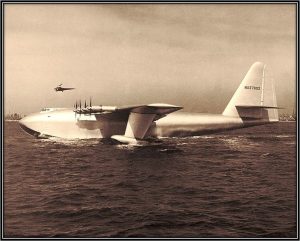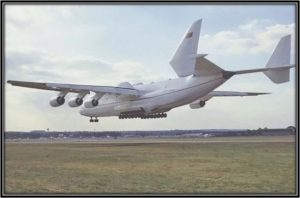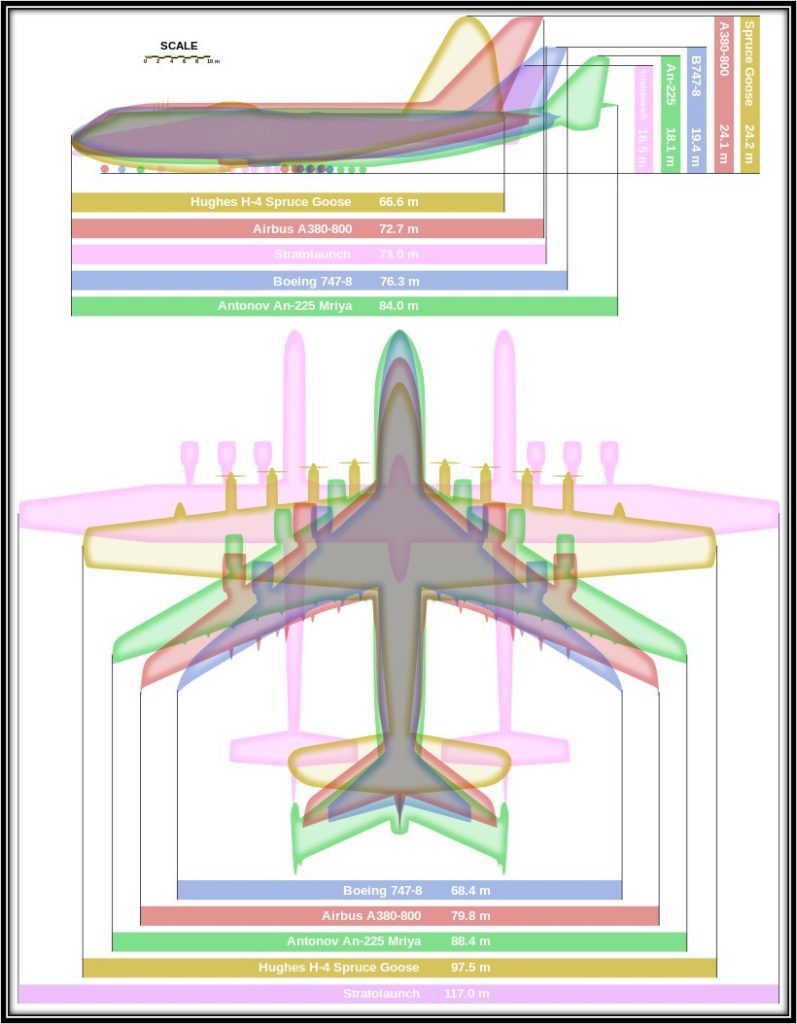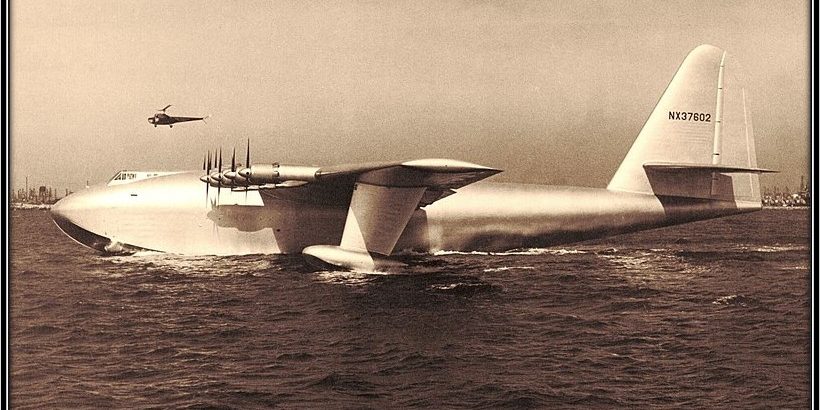The Spruce Goose and Other Aviation Behemoths
Contributor: Barry Fetzer
Sources: Wikipedia, Sometimes Interesting.
One of humankind’s eternal questions, “Does size really matter?” is the subject of today’s aviation history vignette. Like most things in life, the answer is, “It depends.” Notwithstanding the question—and answer—as it may be posed in other areas of our lives, size does matter in aircraft, especially depending on the designed mission of the aircraft. Today we’ll take a look at three of the world’s largest airplanes…ever built…and the question of which is the largest is answered by “It depends.” It depends on the criteria you may be using to answer the question such as wingspan, takeoff maximum gross weight/carrying capacity, or length.
According to Wikipedia, today in 1947 marks “…the first flight of The Hughes Flying Boat—at one time the largest aircraft ever built—piloted by designer Howard Hughes on its first and only flight. Built with laminated birch and spruce (hence the nickname the Spruce Goose) the massive wooden aircraft has a wingspan longer than a football field and was designed to carry more than 700 men to battle.
“Howard Hughes was a successful Hollywood movie producer when he founded the Hughes Aircraft Company in 1932. He personally tested cutting-edge aircraft of his own design and in 1937 broke the transcontinental flight-time record. In 1938, he flew around the world in a record three days, 19 hours, and 14 minutes.
“Following the U.S. entrance into World War II in 1941, the U.S. government commissioned the Hughes Aircraft Company to build a large flying boat capable of carrying men and materials over long distances. The concept for what would become the ‘Spruce Goose’ was originally conceived by the industrialist Henry Kaiser, but Kaiser dropped out of the project early, leaving Hughes and his small team to make the H-4 a reality.
“Because of wartime restrictions on steel, Hughes decided to build his aircraft out of wood laminated with plastic and covered with fabric. Although it was constructed mainly of birch, the use of spruce (along with its white-gray color) would later earn the aircraft the nickname ‘Spruce Goose’. It has a wingspan of 320 feet and was powered by eight giant propeller engines.
“Development of the ‘Spruce Goose’ cost a phenomenal $23 million and took so long that the war had ended by the time of its completion in 1946. The aircraft had many detractors, and Congress demanded that Hughes prove the plane airworthy. On November 2, 1947, Hughes obliged, taking the H-4 prototype out into Long Beach Harbor, CA for an unannounced flight test. Thousands of onlookers had come to watch the aircraft taxi on the water and were surprised when Hughes lifted his wooden behemoth 70 feet above the water and flew for a mile before landing.

The Hughes H-4 Hercules “Spruce Goose” in taxi testing. Public Domain.
“Despite its successful maiden flight, the Spruce Goose never went into production, primarily because critics alleged that its wooden framework was insufficient to support its weight during long flights. Nevertheless, Howard Hughes, who became increasingly eccentric and withdrawn after 1950, refused to neglect what he saw as his greatest achievement in the aviation field. From 1947 until his death in 1976, he kept the Spruce Goose prototype ready for flight in an enormous, climate-controlled hangar at a cost of $1 million per year. Today, the Spruce Goose is housed at the Evergreen Aviation Museum in McMinnville, Oregon.
“The Spruce Goose remains one of the largest aircraft ever built. While it has been surpassed over the years in terms of wingspan, length, height, and weight, it is still the largest seaplane, the largest wooden plane, and the largest propeller-driven plane. Ever.”
So, what’s the world’s largest aircraft today? Well, all things considered, the trophy for being the biggest probably belongs to the Antonov An-225 Mriya.

The Antonov An-225 Mriya. Courtesy of By Sometimes Interesting.
From the website By Sometimes Interesting, “Bigger than a Boeing 747 and Airbus A380, longer and heavier than the Hughes H-4 ‘Spruce Goose’, The Antonov An-225 Mriya is a strategic airlift cargo aircraft developed by the Antonov Design Bureau in the Ukraine and stands as the largest aircraft in the world.
“Known for its immense carrying capability, the An-225 can carry 550,000 lbs. internally or 440,000 lbs. on the upper fuselage. A behemoth with the sole mission to carry cargo, the An-225 requires six turbofan engines to keep its payload in the air.
History
“It was originally designed to function as a Russian Space Shuttle carrier aircraft, assisting the Buran space shuttle of the Soviet Space Program with transport. The plans were first laid out by thee Antonov Design Bureau in the early 1980s, but the first operational flight wouldn’t occur until December 21, 1988.
“Only one An-225 was built; initial plans were to build several An-225’s, but the collapse of the Soviet Union in 1991 saw the cancellation of the Buran space program and the associated Antonov contracts.
“Despite this, a second aircraft was partially constructed – but never finished.”
And now for another of the world’s largest aircraft, this time a plane, again, designed and built by the good ol’ US of A: the Scaled Composites Model 351 Stratolaunch or Roc (named after the mythical bird large enough to carry an elephant) that, according to Wikipedia, “is an aircraft built by Scaled Composites for Stratolaunch Systems to carry air-launch-to-orbit (ALTO) rockets, and subsequently repurposed to offer air launch hypersonic flight testing after a change of ownership. It was announced in December 2011, rolled out in May 2017, and flew for the first time on April 13, 2019, shortly after the death of founder Paul Allen. The aircraft features a twin-fuselage design and the longest wingspan ever flown, at 385 feet, surpassing the Hughes H-4 Hercules ‘Spruce Goose’ flying boat of 321 feet. The Stratolaunch is intended to carry a 550,000-pound (250 t) payload and has a 1,300,000-pound (590 t) maximum takeoff weight.
“The company ceased operations in May 2019, shortly after the first flight, and placed all company assets, including the aircraft, for sale by June 2019. In October 2019, Cerberus Capital Management acquired Stratolaunch Systems, including the Stratolaunch aircraft. Stratolaunch announced in December 2019 that it would now be focusing on offering high-speed flight test services. As of April 2023, the Stratolaunch has flown ten times, including three with a hypersonic test aircraft, and been declared operational.


The “Roc” and A Comparison of world’s largest aircraft. Courtesy of Wikipedia.
“The Roc aircraft has a wingspan about 20 ft wider than the length of an Apollo-era Saturn V and about half as long as the Hindenburg class airships. This makes it the largest airplane, by wingspan, ever to fly. It requires a runway at least 12,000 feet long.”







